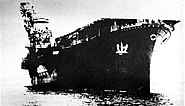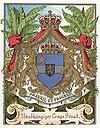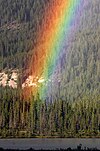User:Rfl/FeaturedArticle
Featured articles[edit]
Featured articles · candidates · collaboration of the week
June 20[edit]
Hiyō (Flying Hawk) was the name ship of her class of two aircraft carriers of the Imperial Japanese Navy. Begun as the ocean liner Izumo Maru in 1939, she was purchased by the Navy Ministry in 1941 for conversion to an aircraft carrier. Completed shortly after the Battle of Midway in June 1942, she participated in the Guadalcanal campaign, but missed the Battle of the Santa Cruz Islands in October because of an electrical generator fire. The carrier's aircraft were disembarked several times and used from land bases in battles in the South West Pacific. Hiyō was torpedoed in mid-1943 and spent three months under repair. She spent most of the next six months training and ferrying aircraft before returning to combat. She was sunk by a gasoline-vapour explosion caused by an American torpedo hit during the Battle of the Philippine Sea on 20 June 1944 with the loss of 247 officers and ratings, about a fifth of her complement. (This article is part of a featured topic: Hiyō class aircraft carrier.)
April 20[edit]
While Russia has existed as a state for over a thousand years, the history of post-Soviet Russia is brief, dating back only to the collapse of the Soviet Union in late 1991. Since gaining its independence, Russia claimed to be the legal successor to the Soviet Union on the international stage. However, Russia lost its superpower status amid serious economic and political challenges in the 1990s. Scrapping the socialist central planning and state ownership of property of the Soviet era, Russia attempted to build an economy with elements of market capitalism, with often painful results. The development of post-Soviet political institutions has also produced mixed results. By the early-1990s Russia had a system of multiparty electoral politics, but in recent years the presidency has been increasing its already tight control over parliament, regional officeholders, and civil society. (more...)
Recently featured: Apollo 8 – Aramaic – Galveston Hurricane of 1900
March 20[edit]
Cambodia is a constitutional monarchy in Southeast Asia with a population of over 13 million people, most of whom are Theravada Buddhists of Khmer origin. The country is bordered to the west by Thailand, to the north by Laos, to the east by Vietnam and to the south by the Gulf of Thailand. Its geography is dominated by the Mekong river and the Tonle Sap, a lake whose fish account for 60% of the nation's protein intake. The capital is Phnom Penh. There are three main political parties, of which the Cambodian People's Party is the current ruling party. From the 9th century to the 15th century Cambodia was the centre of the Khmer Empire, which for most of this period was based at Angkor. Angkor Wat, the empire's main temple, remains a symbol of the country and its greatest tourist attraction. Cambodia was a protectorate of France from 1863 until independence in 1953. During the 1970s and 1980s the country suffered from civil war and the Khmer Rouge autogenocide. Many people were killed or tortured, or fled abroad as refugees. In the 1990s, however, Cambodia has gained some stability and has begun rebuilding the infrastructure that was lost during those years. (more...)
Recently featured: John Dee – Evolution – Geography of Ireland
February 20[edit]
The Brolga is a bird in the crane family. When first described in 1810, the Brolga was misclassified as Ardea, the genus that includes the herons and egrets. It is in fact a member of the Gruiformes; the order that includes the crakes, rails, and cranes, and as a member of the genus Grus. The bird was then given the name Australian crane in 1865 by John Gould. In 1926 the Royal Australasian Ornithologists Union managed to make Brolga, a popular name derived from a native tongue, the official name of the bird. It is a common wetland congregating bird species in tropical and eastern Australia, well known for its intricate mating dance. (more...)
Recently featured: Xenu – Graffiti – Mor lam
January 20[edit]
The Eifel Aqueduct was one of the longest aqueducts of the Roman Empire. It shows the great skill of the Roman engineers, whose level of technical achievement was lost in the Middle Ages and regained only in recent times. The aqueduct, constructed in AD 80, carried water some 95 km (60 miles) from the hilly Eifel region of what is now Germany to the ancient city of Colonia Claudia Ara Agrippinensum (present-day Cologne). If the auxiliary spurs to additional springs are included, the length was 130 km (80 miles). The construction was almost entirely below ground, and the flow of the water was produced entirely by gravity. A few bridges, including one up to 1,400 m (0.86 miles) in length, were needed to pass over valleys. Unlike some of the other famous Roman aqueducts, the Eifel aqueduct was specifically designed to minimise the above-ground portion to protect it from damage and freezing. (more...)
Recently featured: Bernard Williams – First Crusade – Gender role
December 20[edit]
Severe Acute Respiratory Syndrome (SARS) is an atypical form of pneumonia. It first appeared in November 2002 in Guangdong Province, China. SARS is now believed to be caused by the SARS virus. Around 10% of infected people die. After the People's Republic of China suppressed news of the outbreak both internally and abroad, the disease spread rapidly, reaching neighboring Hong Kong and Vietnam in late February 2003, and then to other countries via international travellers. The last case in this outbreak occurred in June, 2003. In the outbreak, SARS caused 8,069 cases of disease and 775 deaths. There have also been speculations that SARS is a man-made disease - see SARS conspiracy theory. (more...)
Recently featured: Newark, New Jersey – Cathedral of Magdeburg – Soda can stove
November 20[edit]
The Zuiderzee Works were a massive hydraulic engineering project undertaken by the Netherlands during the 20th century. They were built to protect land from flooding and to reclaim land in extensive polders, for farming and housing. Original plans for the works date back to the 17th century, but it was not until 1913, when Cornelis Lely became minister of transport, that official planning started. The single biggest structure in the project was a 32 km long dam, the Afsluitdijk, protecting the Dutch from the North Sea. But to test the waters the small Amsteldiepdijk was built first, construction of which lasted four years and proved to be a valuable learning experience for the much larger Afsluitdijk. When the Afsluitdijk was finished in 1932, the Zuiderzee was completely dammed off and from then on would be called lake IJsselmeer. The inflation-adjusted cost of the dam would be the current equivalent of $710 million. (more...)
Recently featured: Alfred Hitchcock – Regular polytope – Battle of Leyte Gulf
October 20[edit]
Attila the Hun was the last and most powerful king of the European Huns. He reigned from 434 until his death over what was then Europe's largest empire, which stretched from Central Europe to the Black Sea and from the Danube River to the Baltic. During his rule he was among the direst enemies of the Eastern and Western Roman Empires: he invaded the Balkans twice, encircling Constantinople in the second invasion; he marched through France as far as Orleans before being turned back at Chalons; and he drove the western emperor Valentinian III from his capital at Ravenna in 452. Though his empire died with him and he left no remarkable legacy, he has become a legendary figure in the history of Europe: he is remembered as the epitome of cruelty and rapacity in much of Western Europe, while he is lionized as a great king in the national history of Hungary. (more...)
Recently featured: Margin of error – Cyclone Tracy – Roche limit
September 20[edit]
The U.S. Electoral College is a specific form of an electoral college and is the method by which the President and Vice President of the United States are chosen. The Electoral College was established by Article Two, Section One of the U.S. Constitution, and meets every four years with electors from each state. The 23rd Amendment to the Constitution has allowed electors from the District of Columbia to cast votes for the election of the president. The electoral process was modified in 1804 with the ratification of Amendment XII. Presidential elections take place on the Tuesday after the first Monday in November in years evenly divisible by four. Although ballots typically list the names of the Presidential candidates, voters within the 50 states and the District of Columbia actually choose electors when they vote for President. These electors in turn cast the official votes for President. Federal law says that each state's electors meet in their state capitals on the Monday following the second Wednesday of December. There, they cast their electoral votes for President and Vice President. (more...)
Recently featured: Cricket – Tiananmen Square protests – Glass
September 6[edit]
The Warsaw Uprising was an armed struggle during the Second World War by the Polish Home Army (Armia Krajowa) to liberate Warsaw from German occupation and Nazi rule. It started on August 1, 1944 as a part of a nationwide uprising, Operation Tempest. The Polish troops resisted the German-led forces until October 2. An estimated 85% of the city was destroyed during the urban guerrilla war and after the end of hostilities. The Uprising started at a crucial point in the war as the Soviet army was approaching Warsaw. Although the Soviet army was within a few hundred metres of the city from September 16 onward, the link between the uprising and the advancing army was never made. This failure and the reasons behind it have been a matter of controversy ever since. (more...)
Recently featured: Anno Domini – PaX – Behistun Inscription
August 20[edit]
Papal elections are the method by which the Roman Catholic Church fills the office of Bishop of Rome, whose incumbent is informally (but usually) referred to as the Pope. An occasion steeped in centuries-old tradition, a meeting of clergymen held to select the Pope is referred to as a conclave. The term comes from the Latin phrase cum clavi ("with a key"), referring to the "locking away" of the electors during the process. Conclaves have been employed since the Second Council of Lyons decreed in 1274 that the electors should meet in seclusion. They are held in the Sistine Chapel in the Palace of the Vatican. (more...)
Recently featured: Fractal – Barack Obama – Governor-General of India
July 20[edit]
An algorithm is a set of instructions for accomplishing some task which, given a defined set of inputs, will result in some recognisable end-state (contrast with heuristic). The concept of an algorithm is often illustrated by the example of a recipe, although many algorithms are much more complex; algorithms often have steps that repeat (iterate) or require decisions (such as logic or comparison) until the task is completed. Different algorithms may complete the same task with a different set of instructions in more or less time, space, or effort than others. Algorithms are sometimes implemented as computer programs but are more often implemented by other means, such as in a biological neural network (for example, the human brain implementing arithmetic or an insect relocating food), or in electric circuits or in a mechanical device. (more...)
Recently featured: Jim Henson – Christianity – Franks
June 20[edit]
The Voynich Manuscript is a mysterious illustrated book of unknown contents, written some 500 years ago by an anonymous author in an unidentified alphabet and unintelligible language. Over its recorded existence, the VMs has been the object of intense study by many professional and amateur cryptographers — including some top American and British codebreakers of World War II fame — who all failed to decipher a single word. This string of egregious failures has turned the VMs into the Holy Grail of historical cryptology; but it has also given weight to the theory that the book is nothing but an elaborate hoax — a meaningless sequence of random symbols. The book is named after the Russian-American book dealer Wilfrid Voynich, who acquired it in 1912. It is presently item MS 408 in the Beinecke Rare Book Library of Yale University. (more...)
Recently featured: Academia – The Beatles – Leet
May 20[edit]
A fancy cancel is a postal cancellation that includes an artistic design. Although the term may be used of modern machine cancellations that include artwork, it primarily refers to the designs carved in cork and used in 19th century post offices of the United States. When postage stamps were introduced in the US in 1847, postmasters were required to deface them to prevent reuse. A number of offices began to use cork bottle stoppers dipped in ink. These worked well, but would tend to blot out the entire stamp making it difficult to check the denomination, and so clerks began to carve a groove across the middle of the cork, making two semicircles. The carving process seems to have sparked the creativity of clerks across the country, and soon thousands of designs appeared, ranging from shields to skulls to stars, geometrical shapes, animals, plants, and devils with pitchforks. (more...)
Recently featured: Buckinghamshire – Comet – Bob Dylan
April 20[edit]
The Congo Free State was a private colony owned by Léopold II of Belgium between about 1877 and 1908. It included the entire area now known as the Democratic Republic of the Congo, and was the scene of native heartbreak and European brutality, greed and genocide on a colossal scale. In 1908, after Léopold's activities had finally been exposed in the Western press, it became, at least in theory, an orthodox colony of Belgium, and known as the Belgian Congo. (more...)
Recently featured: Trench warfare – Ford Mustang – Asperger's syndrome
March 20[edit]
A rainbow is an optical and meteorological phenomenon that causes a (nearly) continuous spectrum of light to appear in the sky when the sun shines onto falling rain. It is a colored arc with red on the outside and violet on the inside: see color for the full sequence. (more...)
Recently featured: Hutton Inquiry - Geyser - End times














